National University of Singapore
The National University of Singapore (NUS) is a national research university in Singapore. Founded in 1905 as the Straits Settlements and Federated Malay States Government Medical School, NUS is the oldest higher education institution in Singapore. It is consistently ranked within the top 100 universities in the world and the top 3 universities in the Asia-Pacific.[5][6] NUS is a comprehensive research university, offering a wide range of disciplines, including the sciences, medicine and dentistry, design and environment, law, arts and social sciences, engineering, business, computing and music at both the undergraduate and postgraduate levels. NUS's main campus is located in the southwestern part of Singapore, adjacent to Kent Ridge, accommodating an area of 150 ha (0.58 sq mi);[7] the Duke-NUS Medical School, a postgraduate medical school jointly established with Duke University,[8] is located at the Outram campus; its Bukit Timah campus houses the Faculty of Law and Lee Kuan Yew School of Public Policy; the Yale-NUS College, a liberal arts college established in collaboration with Yale University,[9] is located at University Town. NUS has one Nobel Laureate, Konstantin Novoselov, among its faculty.
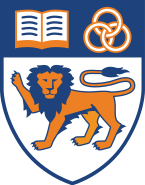 | |
Former names | Straits Settlements and Federated Malay States Government Medical School (1905–1921) King Edward VII College of Medicine (1921–1949) University of Malaya, Singapore campus (1949–1962) University of Singapore (1962–1980) Nanyang University (1956–1980) |
|---|---|
| Type | Autonomous university[1] |
| Established | 1905 (King Edward VII College of Medicine) 6 August 1980 (National University of Singapore) |
| Endowment | S$4.39 billion (2019)[2] ≈ US$ 3.15 billion |
| Chancellor | Halimah Yacob |
| President | Tan Eng Chye |
| Provost | Ho Teck Hua |
Academic staff | 2,555 (2018)[3] |
| Students | 35,908 (2018)[3] |
| Undergraduates | 27,604 |
| Postgraduates | 8,304 |
| Location | 1°17′44″N 103°46′36″E |
| Campus | Urban 150 ha (0.58 sq mi) |
| Colours | Orange and blue |
| Affiliations | ACU, IARU, APRU, Universitas 21, GEM4, AUN, ASAIHL, NUS High School of Mathematics and Science, Association of Professional Schools of International Affairs, Washington University in St. Louis McDonnell International Scholars Academy,[4] UAiTED |
| Website | www |
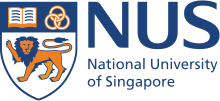 | |
History
In September 1904, Tan Jiak Kim led a group of representatives of the Chinese and other non-European communities to petition the Governor of the Straits Settlements, Sir John Anderson, to establish a medical school in Singapore.[10] Tan, who was the first president of the Straits Chinese British Association, managed to raise 87,077 Straits dollars, of which the largest amount of $12,000 came from himself. On 3 July 1905, the medical school was founded and was known as the Straits Settlements and Federated Malay States Government Medical School.
In 1912, the medical school received an endowment of $120,000 from King Edward VII Memorial Fund, started by Lim Boon Keng. Subsequently, on 18 November 1913, the name of the school was changed to King Edward VII Medical School. In 1921, it was again changed to King Edward VII College of Medicine to reflect its academic status.
In 1928,[11] Raffles College, a separate institution from the medical school, was established to promote arts and social sciences at tertiary level for Malayan students.
University of Malaya (1949–1962)
In 1949, Raffles College was merged with King Edward VII College of Medicine to form University of Malaya on 8 October 1949. The two institutions were merged to provide for the higher education needs of the Federation of Malaya and Singapore.
The growth of University of Malaya was very rapid during the first decade of its establishment and resulted in the setting up of two autonomous divisions in 1959, one located in Singapore and the other in Kuala Lumpur.
Nanyang University (1955-1980)
In 1955, Nanyang University (abbreviated Nantah, 南大) was established on the backdrop of the Chinese community in Singapore.[7]
University of Singapore (1962–1980)
In 1960, the governments of then Federation of Malaya and Singapore indicated their desire to change the status of the divisions into that of a national university.[10] Legislation was passed in 1961, establishing the former Kuala Lumpur division as the University of Malaya, while the Singapore division was renamed the University of Singapore on 1 January 1962.
Present form
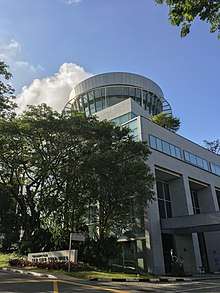
The National University of Singapore (NUS) was formed with the merger of the University of Singapore and Nanyang University on 6 August 1980.[12] This was done in part due to the government's desire to pool the two institutions' resources into a single, stronger entity and promote English as Singapore's main language of education. The original crest of Nanyang University with three intertwined rings was incorporated into the new coat-of-arms of NUS.[13]
NUS began its entrepreneurial education endeavours in the 1980s, with the setting up of the Centre for Management of Innovation and Technopreneurship in 1988. In 2001, this was renamed the NUS Entrepreneurship Centre (NEC), and became a division of NUS Enterprise. NEC is currently headed by Wong Poh Kam[14] and its activities are organised into four areas, including a business incubator, experiential education, entrepreneurship development and entrepreneurship research.
Today, NUS has 17 faculties and schools across three campus locations in Singapore – Kent Ridge, Bukit Timah and Outram – and provides a broad-based curriculum underscored by multi-disciplinary courses and cross-faculty enrichment.
Education
NUS has a semester-based modular system for conducting courses. It adopts features of the British system, such as small group teaching (tutorials) on top of regular two-hour lectures, and the American system (course credits). Students may transfer between courses within their first two semesters, enroll in cross-faculty modules or take up electives from different faculties (compulsory for most degrees). Other cross-disciplinary initiatives study programmes include double-degree undergraduate degrees in Arts & Social Sciences and Engineering; Arts & Social Sciences and Law; Business and Engineering; and Business and Law. At the start of every semester, students are allocated a set number of points with which they use to bid for enrollment to their module of choice. NUS has 16 faculties and schools, including a music conservatory.
NUS offers many programmes for student enrichment, with one of these being the Undergraduate Research Opportunities Program (UROP).[15] Students are expected to spend several hours each week on their projects during the semester, and to work full-time on them during the vacation. UROP is offered in the following Faculties/Schools/Residential College: Arts & Social Sciences, Computing, Dentistry, Engineering, Law, Medicine, Science, University Scholars Programme, and Tembusu College. As every Faculty handles their UROP application slightly different, more information should be sought from the respective faculty.
University rankings
| University rankings | |
|---|---|
| Global – Overall | |
| ARWU World[16] | 67 |
| THE World[17] | 25 |
| USNWR Global[18] | 34 |
| QS World[19] | 11 |
| Regional – Overall | |
| THE Asia[20] | 2 |
| USNWR Asia[21] | 1 |
| QS Asia[22] | 1 |
NUS is ranked 1st in Singapore & Asia Pacific, and 22nd in the world according to the 2018 Times Higher Education World University Rankings,[17] and 11th in the world according to the 2019 QS World University Rankings.[19] NUS was named the world's 4th most international university.[23] In the QS Graduate Employability Rankings 2018, an annual ranking of university graduates' employability, NUS was ranked 30th in the world.[24]
The QS World University Rankings 2019 ranked NUS 11th in the world and 1st in Asia.[19] The Times Higher Education World University Rankings 2018 placed NUS at 22nd in the world and 1st in Asia Pacific,[17] while its 2018 reputation rankings placed it at 24th globally.[25] In 2019, it ranked 27th among the universities around the world by SCImago Institutions Rankings.[26]
Faculties and schools
Arts and Social Sciences
%2C_NUS%2C_February_2020.jpg)
FASS majors are organized into three divisions – Asian Studies, Humanities, and Social Sciences – under which 15 departments and programmes are grouped. It is also home to the Office of Programmes which offers four multidisciplinary programmes and five minor Programmes of study, and the Centre for Language Studies which teaches 12 different languages.[27]
Undergraduate degrees include the Bachelor of Arts (BA), Bachelor of Arts with Honours (BA (Hons)) and Bachelor of Social Sciences with Honours (BSocSci (Hons)).[28]
Business

The NUS Business School was founded as the Department of Business Administration in 1965. It has six departments: Accounting, Strategy and Policy, Decision Sciences, Finance, Management and Organisation, and Marketing.[29]
Graduate programmes offered include the Master of Business Administration (MBA) which currently rank 18th globally according to the Financial Times Global Rankings 2018, NUS MBA Double Degree (conducted jointly with Peking University), UCLA-NUS Executive MBA Programme, Asia-Pacific Executive MBA (English and Chinese), S3 Asia MBA (conducted jointly with Fudan University and Korea University).[30]
Computing
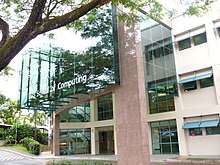
The School of Computing (SoC), established in 1998, has two departments – Computer Science and Information Systems and Analytics. The department of Computer Science offers two undergraduate degree programmes – Computer Science and Information Security, while the department of Information Systems and Analytics offers the other two - Information Systems and Business Analytics.[31]
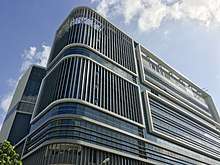
Dentistry
The Faculty of Dentistry had its early beginnings in 1929 as a Department of Dentistry within the King Edward VII College of Medicine. It was the first dental school to be established in a British colony in the East.[32] The faculty conducts a four-year dental course leading to the Bachelor of Dental Surgery (BDS) degree. The undergraduate programme comprises two pre-clinical (first two years) and two clinical years. The Faculty of Dentistry is organised into five academic departments covering the disciplines of Oral Sciences; Oral and Maxillofacial Surgery; Endodontics, Operative Dentistry and Prosthodontics; Periodontics; and Orthodontics and Paediatric Dentistry.
Design and Environment
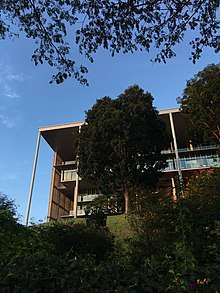
In 1969, the University of Singapore established a new Faculty of Architecture to offer degree programmes in Architecture, Building and Estate Management. Three years later, the Faculty of Architecture was renamed the Faculty of Architecture and Building.
In 1986 the Department of Building Science merged with the Department of Building and Estate Management to form the School of Building and Estate Management which was subsequently renamed the School of Building and Real Estate in 1997. In June 2000 the Faculty of Architecture, Building and Real Estate was reorganised into the three present departments: Department of Architecture, Department of Building and Department of Real Estate, and its name changed to School of Design and Environment (SDE).
Since its establishment 50 years ago, SDE remains the only Faculty or School in a tertiary educational institution in Singapore responsible for offering education in architecture, urban design, building, project and facilities management, and real estate. During this period, graduates from the School contributed to the design, development and management of Singapore's built environment.
In many ways, the growth of the School reflects Singapore's development and its global status. From educating professionals to build the nation in the initial years of its independence, it now prepares culturally sensitive, technically competent and environmentally conscious graduates to make Singapore into a distinctive global city as well as to participate in the development of the built environment overseas, an effort pioneered by the earlier cohorts of our graduates.
The range, scale and complexity of programmes offered by SDE have also changed with the times. At the Department of Architecture, its undergraduate and graduate programmes have evolved from the design of buildings to encompass that of products, cities and landscape. Similarly, for the Departments of Building and Real Estate, the programmes have moved beyond building science to project and facilities management and beyond real estate management to real estate finance and investment. From one engaged essentially in teaching, the School has transformed into one that has significant research capabilities and achievements in certain focus areas. This is important, particularly for a university in a small country for which the next phase of economic development is driven by knowledge and innovation.
Duke–NUS Medical School
The Duke–NUS Medical School is a collaboration between Duke University in North Carolina, United States and the National University of Singapore.[33] It follows the American model of post-baccalaureate medical education.[34] Students begin their medical studies after earning a bachelor's degree. In this way, Duke–NUS is able to offer an opportunity for students with the potential to excel in the field of medicine and biomedical sciences.[35]
Engineering
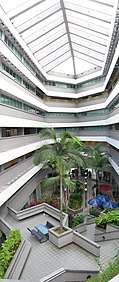
The Faculty of Engineering was launched in 1968. It is the largest faculty in the university and consists of several divisions/departments: Biomedical Engineering; Chemical & Biomolecular Engineering; Civil & Environmental Engineering; Electrical & Computer Engineering; Engineering Science Programme; Industrial Systems Engineering & Management (ISEM); Materials Science & Engineering; and Mechanical Engineering. The Department of Industrial Systems Engineering & Management (ISEM), resulting from a merger between the Department of Industrial & Systems Engineering and Division of Engineering & Technology Management, is similar in structure and research focus to the Department of Management Science & Engineering (MS&E) at Stanford University.
The NUS Faculty of Engineering was ranked 6th in the world by the Academic Ranking of World Universities for Engineering/Technology and Computer Sciences.[36] It has also been ranked 7th in the world in the subject category of Engineering and Technology by the 2017 QS World University Subject Rankings[37] and 2016-2017 Times Higher Education World University Subject Rankings.[38]
Integrative Sciences and Engineering
NUS Graduate School for Integrative Sciences and Engineering (NGS) was established in 2003. The principal purpose of NGS is "to promote integrative Ph.D. research encompassing both laboratory work and coursework programmes which not only transcend traditional subject boundaries but also provides students with a depth of experience about science and the way it is carried out".[39]
NGS’ Ph.D. programmes are firmly anchored in cross-disciplinary research. It offers a spectrum of research areas spanning science, engineering, related aspects of medicine, and interactive & digital media. NGS also offers the following PhD degree programmes.[40]
- Joint NUS-Karolinska PhD Programme
- NUS PhD-MBA
Law
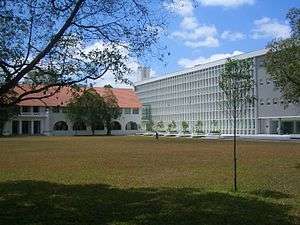
The NUS Faculty of Law was first established as a Department of Law in the then University of Malaya in 1956. The first law students were admitted to the Bukit Timah campus of the university the following year. In 1977, the faculty shifted to the Kent Ridge campus, but in 2006 it relocated back to the Bukit Timah site.
Apart from the traditional LLB which runs for four years, the law school also offers double honours degrees in Business Administration & Law, Economics & Law,[41] Law & Life Sciences,[42] and a concurrent degree programme in Law & Public Policy.[43] For graduate students, the law school offers coursework LLM specialisations[44] in areas such as Corporate and Financial Services Law, Intellectual Property & Technology Law, International & Comparative Law, Maritime Law and Asian Legal Studies.
Medicine
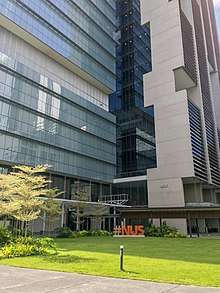
The Yong Loo Lin School of Medicine at NUS was first established as the Straits Settlements and Federated Malay States Government Medical School in 1905. The School comprises departments such as the Alice Lee Centre for Nursing Studies, Anaesthesia, Anatomy, Biochemistry, Diagnostic Radiology, Epidemiology and Public Health, Medicine, Microbiology, Obstetrics & Gynaecology, Ophthalmology, Orthopaedic Surgery, Otolaryngology, Paediatrics, Pathology, Pharmacology, Physiology, Psychological Medicine and Surgery. The School uses the British undergraduate medical system, offering a full-time undergraduate programme leading to the Bachelor of Medicine and Bachelor of Surgery (MBBS). For Nursing, the Bachelor of Science (Nursing) conducted by the Alice Lee Centre for Nursing Studies is offered. The department also offers postgraduate Master of Nursing, Master of Science (Nursing) and Doctor of Philosophy programmes.
Music
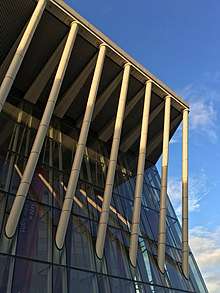
The Yong Siew Toh Conservatory of Music (YSTCM) is a collaboration between NUS and the Peabody Institute of Johns Hopkins University. Singapore's first conservatory of music, YSTCM was founded as the Singapore Conservatory of Music in 2001. The School was renamed Yong Siew Toh Conservatory of Music in recognition of a gift from the family of the late Dr Yong Loo Lin in memory of his daughter.
Public Health
The Saw Swee Hock School of Public Health is Singapore's first and only tertiary education institution for public health.[45] It traces its beginnings to the University of Malaya's Department of Social Medicine and Public Health, formed in 1948.[46] The school collaborates with partners including the London School of Hygiene and Tropical Medicine, Karolinska Institutet, Harvard School of Public Health and University of Michigan School of Public Health.[45]
Public Policy
The Lee Kuan Yew School of Public Policy was formally established in 2004 as an autonomous graduate school of NUS. Although the School was formally launched in 2004, it inherited NUS' Public Policy Programme, which was established in 1992 in partnership with Harvard University's John F Kennedy School of Government.
Science
.jpg)
The Faculty of Science comprises the departments of Biological Sciences, Chemistry, Food Science & Technology, Mathematics, Pharmacy, Physics, and Statistics & Applied Probability and offers degree programmes in Chemistry, Computational Biology, Data Science & Analytics, Environmental Studies (Environmental Biology), Food Science & Technology, Life Sciences, Mathematics/Applied Mathematics, Pharmaceutical Science, Pharmacy, Physics, Quantitative Finance, and Statistics. The first female Dean of the Faculty of Science was Gloria Lim, who was appointed in 1973. She served a four-year term and was reappointed in 1979, but resigned after one year to allow Koh Lip Lin to continue his post. In 1980, University of Singapore merged with Nanyang University to form NUS, resulting in overlapping posts.[47]
University Scholars Programme
The University Scholars Programme (USP) is an undergraduate academic programme established in 2001 in NUS. Each year, USP admits around 200 undergraduates from across seven faculties and schools in NUS.
The USP education focuses on strengthening core academic and professional skills – writing and critical thinking, analytical and quantitative reasoning, the ability to ask the right questions and pursue research, and the habit of reflecting upon ideas within a broad intellectual landscape. This is done through an intensive and rigorous multi-disciplinary curriculum, and a rich offering of local and international programmes. USP's focus on core skills complements the students’ strengths in their major disciplines, enabling them to make substantial connections across fields, enhancing their intellectual depth and breadth.
USP students reside in Cinnamon College at the NUS University Town. Alongside a vibrant student life, the residential college is a space for discussions on diverse issues, allowing students to develop meaningful engagement with real-world matters.
Yale-NUS College
The Yale-NUS College is a liberal arts college in Singapore which opened in August 2013 as a joint project of Yale University and the National University of Singapore. It exists as an autonomous college within NUS, allowing it greater freedom to develop its own policies while tapping on the existing facilities and resources of the main university.[48] Students who graduate receive a Bachelor of Arts (Honours) or a Bachelor of Science (Honours) degree from Yale-NUS College awarded by NUS.[48]
Pericles Lewis, a former professor at Yale, was appointed as the founding president in 2012.[49][50][51][52]
Teaching centres
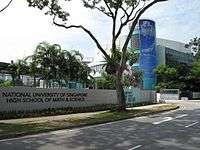
NUS has a variety of teaching centres including:
- Centre for Development of Teaching and Learning (CDTL), which is the NUS academic development unit and in that capacity seeks to support teaching so as to improve student learning.
- Centre for Instructional Technology (CIT), which provides for the exploration, development and application of digital and audio-visual technologies to support and enhance teaching and learning. This is done through the NUS-developed Integrated Virtual Learning Environment and by developing new applications/services and incorporating multimedia content in courses for academia.[53]
- Centre for English Language Communication (CELC).
- Institute of Systems Science (ISS), which offers professional information technology continuing education to managers and IT practitioners.
- Centre for Teaching and Learning CTL at Yale-NUS College supports academic development in the distinctive pedagogy of liberal arts education. Efforts focus in many areas, but especially in team-based learning, student-centred learning, grading and assessment, effective classroom discussion, impactful feedback, and intercultural engagement for all the divisions - Sciences, Social Sciences, and Humanities.
NUS High School of Mathematics and Science
NUS High School of Mathematics and Science is a school specialising in mathematics and science, and provides secondary and pre-tertiary education to many students with an inclination to these fields.
Research
Among the major research focuses at NUS are biomedical and life sciences, physical sciences, engineering, nanoscience and nanotechnology, materials science and engineering, infocommunication and infotechnology, humanities and social sciences, and defence-related research.
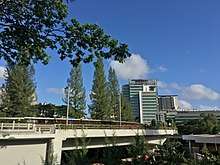
One of several niche research areas of strategic importance to Singapore being undertaken at NUS is bioengineering. Initiatives in this area include bioimaging, tissue engineering and tissue modulation. Another new field which holds much promise is nanoscience and nanotechnology. Apart from higher-performance but lower-maintenance materials for manufacturing, defence, transportation, space and environmental applications, this field also heralds the development of accelerated biotechnical applications in medicine, health care and agriculture.
Research institutes and centres
Currently, NUS hosts 21 university-level research institutes and centres (RICs) in various fields such as research on Asia, risk management, logistics, engineering sciences, mathematical sciences, biomedical and life sciences, nanotechnology to marine studies. Besides that, NUS also hosts three Research Centres of Excellence, namely, the Cancer Science Institute of Singapore, Centre for Quantum Technologies and Mechanobiology Institute, Singapore – a partner in Singapore's fifth Research Centre of Excellence. Besides university-level RICs, NUS also has close affiliation with many national research centres and institutes.[54] A special mention is required for The Logistics Institute – Asia Pacific, which is a collaborative effort between NUS and the Georgia Institute of Technology for research and education programmes in logistics.[55] NUS announced its most recent research institute, the New Age Institute, a partnership with Washington University in St. Louis, in February 2015.[56]
| Name | Description |
|---|---|
| Asia Research Institute | The Asia Research Institute focuses on research on Asia. Within NUS it works particularly with the Faculties of Arts and Social Sciences, Business, Law, and Design to support conferences, lectures and graduate study. |
| Cancer Science Institute of Singapore | Established on 15 October 2008, Cancer Science Institute (CSI) of Singapore is dedicated to investigating the pathogenesis of cancer and creating innovative, safer methods of diagnosis and treatment. |
| Centre for Advanced 2D Materials | Established in 2014, the Centre for Advanced 2D Materials is dedicated to the exploration, synthesis, and development of new devices based on two-dimensional (2D) materials, of which graphene is the most famous. |
| Centre of Healthcare Innovation and Medical Engineering | The Centre for Innovation in Healthcare (CIH) aims to develop and implement new models of care, incorporating smart technologies as well as innovations in research and training to meet present and future national healthcare needs. It also tests healthcare solutions, including new devices, technologies and work processes, at scale. |
| Centre for International Law | The Centre for International Law was established in 2009 to provide a focal point for international law thought leadership and capacity building in the Asia-Pacific region. CIL's focus areas of research and training are ocean law and policy, ASEAN law and policy, investment law and policy, and international law and practice. |
| Centre For Maritime Studies | Specializing in maritime affairs, the Centre for Maritime Studies was launched on 29 June 2005 to undertake research in areas of relevance to the industry, so as to share timely information, research data and informed views of current topics. In addition, it provides consultancy services on specific maritime matters on demand. |
| Centre for Quantum Technologies | Established in December 2007, the Centre for Quantum Technologies conducts research on fundamental quantum physics and on devices based on quantum phenomena. |
| Centre For Remote Imaging, Sensing And Processing | Established with funding from the Agency for Science, Technology & Research (A*STAR) of Singapore, CRISP undertakes research in optical and microwave remote sensing technology and applications. The current research interest areas are ocean and coastal studies, tropical vegetation studies, and remote sensing data processing techniques. In addition, CRISP provides custom-produced remote sensing products, as well as training and consultation services in the field of remote sensing. |
| East Asian Institute | Set up in April 1997, the East Asian Institute promotes both academic and policy-oriented research on East Asian development. EAI organizes seminars and publishes research papers on a regular basis. EAI also participates in joint research projects with government ministries and statutory boards in Singapore, promotes collaborative programmes with similar institutions in the region as well as organizes regional and international conferences and workshops on East Asian issues. |
| Energy Studies Institute | The Energy Studies Institute conducts research on energy policies and their national, regional and global implications to inform energy policy. |
| Institute for Mathematical Sciences | Established on 1 July 2000 with startup funding from the Ministry of Education and NUS, the Institute fosters fundamental and multidisciplinary mathematical research and nurtures mathematical expertise among research scientists through research programmes, summer schools, conferences, stand-alone workshops, colloquium lectures and ad-hoc seminars. |
| Institute of Real Estate Studies | Officially inaugurated on 1 June 2006, the Institute undertakes multidisciplinary research in real estate in relation to finance, economics, urban development, wealth accumulation, demography, and environmental policies etc. |
| Institute of South Asian Studies | ISAS is dedicated to research on contemporary South Asia. |
| Interactive And Digital Media Institute | The Institute explores commercially creative interactive media research. |
| Life Sciences Institute | The Life Sciences Institute (LSI) conducts research on fundamental biological pathways in human health and disease, environmental science and industrial processes. Focus programmes include Immunology, Ageing, Neurobiology, Lipid Research, Tissue Engineering and Human Variation combined with hosting the Singapore Centre on Environmental Life Sciences Engineering (SCELSE), the Singapore Institute of Neurotechnology (SINAPSE) and the Clinical Imaging Research Centre (CIRC). |
| Mechanobiology Institute | MBI's scientific research is focused on the dynamical and mechanical aspects of biological functions. |
| Middle East Institute | Founded in 2007, the Middle East Institute (MEI) conducts research to understand the Middle East, and to deepen engagements between the Middle East and Asia. It also conducts publications, lectures, consultations and outreach for exchange of ideas between Singapore and the Middle East and hosts speakers and visitors from and on the Middle East. |
| New Age Institute | The Next Age Institute is a partnership between the National University of Singapore (NUS) and Washington University in St. Louis to study, design and test social innovations. |
| NUS Environmental Research Institute | NERI is a university-level research institute that focuses on the development of integrated sustainability solutions for the environment. It collaborates with the government, industry, NGOs and leading academic partners to ensure that its research consistently addresses real-world issues. |
| NUS Global Asia Institute | Founded by former NUS President Tan Chorh Chuan in September 2009, the Global Asia Institute conducts interdisciplinary research in a wide range of topics, including health, environment and demographic issues in Asia, with its current focus on behavioral change and healthcare. |
| NUS Nanoscience And Nanotechnology Initiative | - |
| NUS (Suzhou) Research Institute | NUSRI reinforces cooperation between China and Singapore in technology and education by conducting research to enhance the scientific, economic and industrial thrusts of Jiangsu and China. |
| Risk Management Institute | Supported by the Monetary Authority of Singapore (MAS) under its program on Risk Management and Financial Innovation, the NUS Risk Management Institute (RMI) was established in 2006 to research financial risk management. |
| Singapore Institute For Neurotechnology | - |
| Singapore Nuclear Research And Safety Initiative | The Singapore Nuclear Research and Safety Initiative (SNRSI) was established to concentrate expertise and knowledge in nuclear technology and safety in a single institute, and sustain a critical mass of manpower engaged in a range of nuclear-related activities relevant to Singapore. |
| Singapore Synchrotron Light Source | SSLS conducts research involving the use of synchrotron radiation, including micro/nanofabrication, analytical applications and advanced synchrotron radiation instrumentation. |
| Solar Energy Research Institute Of Singapore | Having commenced operations in 2008, SERIS conducts research, development, testing and consulting on solar energy technologies and their integration into power systems and buildings. The institute's R&D spectrum covers materials, components, processes, systems and services, with an emphasis on solar photovoltaic cells, modules and systems. SERIS is globally active but focuses on technologies and services for tropical regions, in particular for Singapore and South-East Asia. |
| Temasek Laboratories | Launched on 6 September 2000, Temasek Laboratories conducts research in selected areas of science and technology critical to Singapore's requirements, such as aeronautical sciences, electromagnetics and information security. |
| The Logistics Institute-Asia Pacific | |
| Tropical Marine Science Institute | TMSI undertakes research, development and consultancy in tropical marine science as well as environmental science. It handles projects relevant to Physical Oceanography, Acoustics, Marine Biology, Marine Mammals, Biofuels, Water Resources and Climate Change. TMSI also provides postgraduate research opportunities. Currently located on the NUS campus, the TMSI also has coastal facilities on St. John's Island. |
Major research facilities
Comparative Medicine was set up to provide professional and technical service for laboratory animal care, veterinary medical services, and animal research project support for NUS staff and students.
National University Medical Institutes focuses its efforts on the development of centralised research facilities and services for the Yong Loo Lin School of Medicine at NUS and developing research programmes in cancer and cardiovascular diseases.[58]
Entrepreneurship
NUS began its entrepreneurial education endeavours in the 1980s, with the setting up of the Centre for Management of Innovation and Technopreneurship in 1988. In 2001, this was renamed the NUS Entrepreneurship Centre (NEC), and became a division of NUS Enterprise. NUS Enterprise is the entrepreneurial arm of NUS. Its activities are organised into 4 areas, including a business incubator,[59] entrepreneurial education, entrepreneurship outreach and technology commercialisation.
The NUS Overseas Colleges (NOC) programme was started in 2001, giving students the opportunity to experience, live, work and study in an entrepreneurial hub. Participants of the programme either spend 6 months or a year overseas, taking courses at partner universities and working in start-ups.[60] The program is offered at twelve different locations: Silicon Valley and New York in the United States, Toronto in Canada, Shanghai, Beijing and Shenzhen in China, Stockholm in Sweden, Munich in Germany, Lausanne in Switzerland, Israel, Singapore and Southeast Asia (Jakarta and Vietnam).
The NUS Industry Liaison Office (ILO) is a part of NUS Enterprise. It manages the University's technology transfer and promotes research collaborations with industry and partners. ILO manages NUS intellectual property, commercialises its intellectual assets and facilitates the spinning off of technologies into start-up companies.[61]
Campus facilities and resources
IT and computing services
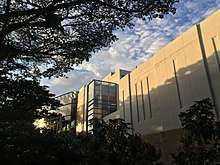
The IT facilities and network are generally provided by its central IT department, Computer Centre. NUSNET is used in research, teaching, learning and administration. In 2004, a campus-wide grid computing network based on UD Grid MP was deployed, connecting at least 1,000 computers. This becomes one of the largest such virtual supercomputing facilities in the region.[62]
NUS used Internet2 technology to make distance learning possible. Students from Singapore and Massachusetts Institute of Technology were able to learn and interact in one virtual classroom.[63]
Library services
The NUS Libraries comprises 8 libraries, namely, the Central Library, Chinese Library, CJ Koh Law Library, Hon Sui Sen Memorial Library, the Medical Library, Music Library, Science Library and East Asian Institute Library. Its primary clients are NUS and NUS-affiliated research institutes, students, teaching faculty, research and administrative staff members, as well as a sizeable group of external members. Its collection encompasses subjects in architecture, building and real estate, business, dentistry, engineering, computer science, the humanities and social sciences, law, medicine, music, nursing and science. As of June 2017, there are 2,354,741 unique titles, and 26,074 microform resources[64] in the collection.[65]
NUS University Town
.jpg)
The NUS University Town (UTown) opened in August 2011. Located across the NUS Kent Ridge campus, it was built on the site of a former golf course.[66] This is where 2,400 undergraduate students, 1,700 graduate students and 1,000 researchers work, live, and learn in close proximity. There are four residential colleges: Cinnamon College, Tembusu College, College of Alice & Peter Tan, and Residential College 4 – initially named Cinnamon, Tembusu, Angsana and Khaya, respectively. An Education Resource Centre, the Stephen Riady Centre and a Graduate Residence are also located here.[67]
Accessibility
There are several internal shuttle buses that run throughout NUS: A1, A2, D1, D2, B1, B2, C, BTC1, BTC2, A1E, A2E, and AV1. Information on bus routes can be found in the NUS NextBus app. The Kent Ridge campus can be accessed by taking a shuttle bus from the Kent Ridge MRT station (CC24). The Bukit Timah campus is located close to the Botanic Gardens MRT station (CC19).
Student accommodation
NUS has three types of student accommodation: Halls of residence; Student residences; and Residential colleges. There are about 6,000 residential places distributed between Halls of Residence and Student Residences on campus, in addition to around 4,100 students who live in the residential colleges and graduate residences at University Town.[68] There are free Internal Shuttle Buses that ply the entire campus seven days a week.[69]
Halls of residence
NUS has 7 Halls of Residence with about 3,000 residential places. Halls have their own interest groups and regular student productions, in addition to university-wide student co-curricular activities. Halls compete with each other in the Inter-Hall Games.
The Halls of Residence are:[70]
- Eusoff Hall (345 single rooms; 70 double rooms)
- Kent Ridge Hall (507 single)
- King Edward VII Hall (350 single; 60 double)
- Raffles Hall (213 single; 128 double)
- Sheares Hall (509 single)
- Temasek Hall (345 single; 70 double)
- Prince George's Park House (626 single)
Student residences
NUS also has 3 Student Residences for undergraduate students with clusters of 11 to 15 single rooms with their own kitchen and bathroom facilities. Kitchen and dining areas are equipped with basic cooking appliances. The NUS University Town houses the Graduate Residence for graduate students with the option of both apartments and single rooms.[71] Residences generally do not have co-curricular activities.
The Student Residences are:[72]
- Kuok Foundation House
- Prince George's Park Residences
- Graduate Residences
Residential colleges
The more recent residential developments at NUS are residential colleges, modeled after the residential college systems of universities in the United Kingdom and the United States. Like halls, residential colleges have unique co-curricular activities. Residential colleges also have their own academic programmes, with general education (GE) requirements different from each other and from the rest of the University. The academic programmes in residential colleges take place in small-sized seminar classes.
Cinnamon College
Cinnamon College houses the University Scholars Programme (USP). Around 620 students live in the USP residential college, which contains the administrative and faculty offices for USP as well as teaching classrooms.
USP students take modules at the college and follow the current USP curriculum. They are required to take eight multi-disciplinary modules specially designed for USP students, including Writing and Critical Thinking, Quantitative Reasoning Foundation, and the University Scholars Seminar. Students have various options to fulfil their USP advanced curriculum requirements that include individual research with faculty mentors, and industrial and entrepreneurial attachments.[73]
Tembusu College
Tembusu College is one of the first two Residential Colleges in NUS University Town, an extension to the main NUS campus at Kent Ridge. Tembusu houses mainly undergraduates, in addition to resident faculty, distinguished visiting scholars and a few graduate fellows.
The college offers five multi-disciplinary modules fulfilling the "University-Level Requirements" (2 General Education modules, 2 Breadth modules, and 1 Singapore Studies module) which most NUS undergraduates must read to graduate. Students read the rest of their modules in their home faculties. A University Town Residential Programme Certificate is issued to eligible students, along with the regular degree scroll. Students from non-modular faculties (i.e. Law, Medicine and Dentistry) also belong to the college, but with coursework tailored to their specific programmes. The Rector of Tembusu College is Singapore's Ambassador-at-Large and former United Nations Ambassador Tommy Koh, who is also the former Dean of the NUS Faculty of Law.
College of Alice & Peter Tan
The College of Alice & Peter Tan (CAPT) is a Residential College for all NUS undergraduates. In addition to providing a two-year academic programme (the University Town College Programme), CAPT is distinguished by the vision of helping students engage with the community within and outside of NUS. It consciously weaves the theme of active citizenship and community engagement through its curriculum and other aspects of the student experience.
Residential College 4
Residential College 4 (RC4) is the newest Residential College in NUS University Town to offer the University Town College Programme (UTCP). RC4 believes in catalysing a generation of systems citizens in Singapore by employing systems thinking and systems dynamic modelling to elicit mental models to emulate the complexity of the problems around us – such as population dynamics, diseases and healthcare.
Recent events and highlights of RC4 included the holding of the 2nd Asia-Pacific System Dynamics Conference 2017, RC4 Arts Night 2017: P.U.L.S.E, Cognitio Teas with various experts of varying fields, Rector's Tea, as well as volunteering events such as Popiah Making with Senior Citizens @ Lions Befrienders (Clementi) and DroneLive@UTown. More information about the college can be found at NUS RC4

Ridge View Residential College
Ridge View Residential College (RVRC) was formally established in April 2014, housed in the former Ridge View Residences. It is the only residential college that is situated outside University Town. The low-rise interconnected buildings are nestled against the backdrop of the Kent Ridge Forest, visually distinct with their brick-clad exteriors, open courtyards and heritage trees. The site was the former location for Kent Ridge Hall until November 2002. As the college program gradually evolved and the student community grew, construction began in November 2015 for a new building to complement the needs of the college. The new Annex building became operational in March 2017.
List of principal officers
The following table is a list of the principal officers of the National University of Singapore's predecessors. Note that the office of the President of Raffles College was renamed Principal of Raffles College from 1938.[74]
| Principals (King Edward VII Medical College) |
Presidents and Principals * (Raffles College) | ||
|---|---|---|---|
| Gerald Dudley Freer | 1905–1909 | Richard Olaf Winstedt | 1928–1931 |
| R. D. Keith | 1909–1918 | James Watson | 1932–1934 |
| G. H. MacAlister | 1918–1929 | Frederick Joseph Morten | 1935–1937 |
| George V. Allen | 1929–1947 | Alexander Keir | 1937–1938 |
| D. W. G. Faris | 1947–1949 | George McOwan | 1938–1941 |
| Bill Patiten | 1949–present | W. E. Dyer | 1946–1948 |
| George V. Allen | 1948–1949 | ||
Alumni
Since its inception in 1905, NUS has had many distinguished alumni, including 4 Singaporean Prime Ministers and Presidents, 2 Malaysian Prime Ministers, politicians, judiciaries, business executives, educators and local celebrities. It counts among its graduates heads of states Abdul Razak Hussein, Benjamin Sheares, Goh Chok Tong, Mahathir Mohamad and S. R. Nathan. A number of its graduates are also notable politicians such as Rais Yatim, Malaysia's former Minister for Information, Communications and Culture and Ng Eng Hen, Singapore's current Minister of Defence.
Business leaders such as former Chairman of the Singapore Exchange and Singapore Tourism Board Chew Choon Seng, CEO of the Hyflux Group Olivia Lum, CEO of the Temasek Holdings Ho Ching, Chairman of SPRING Singapore Philip Yeo and CEO of Razer Inc Min-Liang Tan.
In international politics, the school has produced the Director General of World Health Organization Margaret Chan, former Presidents of United Nations Security Council Kishore Mahbubani and S Jayakumar, and Vice-President of the International Olympic Committee Ng Ser Miang.
In Singapore's legal sector, NUS served as Singapore's only law school for half a century, until the Singapore Management University was set up in 2007. Therefore, most of Singapore's judiciaries come from the school. This includes Singapore's Minister for Law and for Home Affairs and former Minister for Foreign Affairs K. Shanmugam, the fourth Chief Justice of Singapore Sundaresh Menon and the third Chief Justice of Singapore Chan Sek Keong.
In academia, NUS boasts of President Emeritus of Nanyang Technological University Su Guaning, Former Vice-President of Finance for University of Virginia and Cornell University Yoke San Reynolds, and former Vice-Chancellor of the University of Hong Kong Wang Gungwu.
 Alumnus Goh Chok Tong, Singapore's second Prime Minister
Alumnus Goh Chok Tong, Singapore's second Prime Minister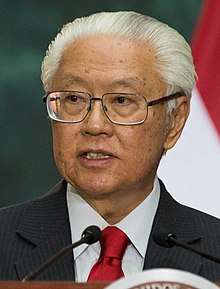 Alumnus Tony Tan Keng Yam, Singapore's seventh President
Alumnus Tony Tan Keng Yam, Singapore's seventh President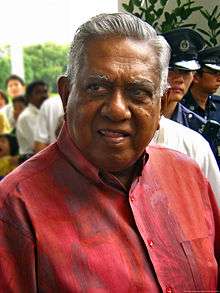 Alumnus S. R. Nathan, Singapore's sixth and longest-serving President
Alumnus S. R. Nathan, Singapore's sixth and longest-serving President.jpg) Alumnus Mahathir Mohamad, 4th and 7th Prime Minister of Malaysia
Alumnus Mahathir Mohamad, 4th and 7th Prime Minister of Malaysia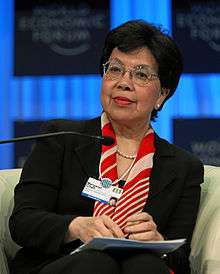 Alumna Margaret Chan, Director-General of the World Health Organization
Alumna Margaret Chan, Director-General of the World Health Organization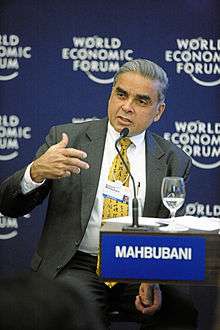 Alumnus Kishore Mahbubani, Former President of the United Nations Security Council
Alumnus Kishore Mahbubani, Former President of the United Nations Security Council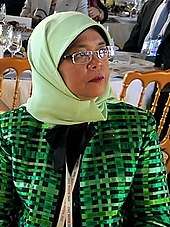 Alumna Puan Yang Terutama Halimah Yacob, Singapore's eighth President (current)
Alumna Puan Yang Terutama Halimah Yacob, Singapore's eighth President (current) Alumnus Dr. Ng Eng Hen, Singapore's Defence Minister (current)
Alumnus Dr. Ng Eng Hen, Singapore's Defence Minister (current)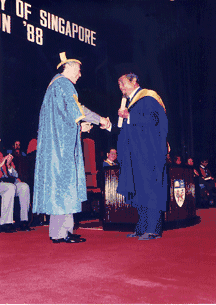
Controversies
Controversies at NUS generally steer clear from the media limelight apart from rare high-profile cases.[75][76] Recent cases include the imprisonment of assistant law professor Sundram Peter Soosay for assaulting a taxi driver while drunk,[77][78] and the death of first-year scholar Peter Huen Kam Fai, who hanged himself at Cinnamon College.[79]
Law professor Tey Tsun Hang was also tried for allegedly offering better grades in exchange for sex, and was sentenced to five months in jail in June 2013. In February 2014, his verdict was overturned on appeal to the high court and he was acquitted of all charges. Despite this outcome, his attempt to regain permanent residency status in Singapore failed in December 2014.[80]
On 19 April 2019, a sexual misconduct incident, of which a female student, Monica Baey Beiermann, was filmed while showering in a student hostel by a fellow male student was revealed by the victim. The perpetrator was given one semester suspension by the university and a conditional warning by the police.[81] It was later revealed that there were 26 incidents of sexual offences reviewed by the NUS Board of Discipline over a three-year period, with no expulsions issued.[82] The university maintains a two-strike policy on such cases, arguing that as an educational institution, it prefers to give the offender a chance.[83] Educational Minister Ong Ye Kung commented that such penalties are "manifestly inadequate" and had asked the universities in Singapore to review their policies.[84][85] The university had also apologised for its handling of the issue.[86] The university, Singapore Management University and Nanyang Technological University have since commented that they are reviewing their disciplinary policies in light of this incident.[87][88] As a result, NUS convenes a review committee,[89] and two petitions demanding stiffer penalties are launched[90][91] Bathroom security was subsequently tightened with covered entrances and more security guards in place.[92] On 10 June 2019, the committee released recommendations for tougher penalties, which NUS accepted.[93] On 29 August 2019, NUS has set up a Victim Care Unit for victims who have encountered some form of sexual misconduct.[94]
See also
- National University Hospital
- Nanyang University
- S*, a collaboration between seven universities and the Karolinska Institutet for training in bioinformatics and genomics
References
- "Post-secondary education". Ministry of Education, Singapore. Ministry of Education, Singapore. Archived from the original on 5 April 2008. Retrieved 11 June 2015.
- "Financial Report 2019" (PDF). National University of Singapore and its Subsidiaries. 25 June 2020. p. 79.
- "Annual Report 2018" (PDF). National University of Singapore. Retrieved 1 February 2019.
- "McDonnell International Scholars Academy". Global.
- https://www.usnews.com/education/best-global-universities/rankings
- https://www.topuniversities.com/university-rankings/asian-university-rankings/2019
- "History". NUS Bulletin. National University of Singapore. Retrieved 29 January 2019.
- "About Duke-NUS Medical School". Duke School of Medicine.
- "Yale-NUS College". Yale College Undergraduate Admissions.
- Loo Lay Yen. "National University of Singapore: A Brief Chronological History". Lib.nus.edu.sg. Archived from the original on 20 June 2016.
- "National University of Singapore website – Milestones". Nus.edu.sg. Archived from the original on 3 April 2012.
- "History". National University of Singapore. Retrieved 29 June 2019.
- "Milestones". National University of Singapore. Archived from the original on 15 October 2007. Retrieved 11 August 2007.
- Chng, Grace (20 May 2012). "Start-up godfather". The Straits Times. Archived from the original on 10 June 2012.
- "Undergraduate Research Opportunities". Undergraduate Research Opportunities. Retrieved 6 September 2019.
- "ARWU World University Rankings 2019 - Academic Ranking of World Universities 2019 - Top 1000 universities - Shanghai Ranking - 2019". www.shanghairanking.com.
- "World University Rankings 2020". Times Higher Education.
- "US News Best Global Universities Rankings". www.usnews.com.
- "QS World University Rankings Results 2020". QS Quacquarelli Symonds.
- "Asia University Rankings 2019". Retrieved 20 October 2019.
- "US News best Best Global Universities in Asia". www.usnews.com.
- "QS University Rankings: Asia 2019". Retrieved 25 November 2018.
- "Most international universities in the world 2018: top 200". Times Higher Education. Retrieved 7 June 2018.
- "QS Graduate Employability Rankings 2018". Quacquarelli Symonds. Retrieved 7 June 2018.
- "Times Higher Education World Reputation Rankings 2018". Timeshighereducation.co.uk. Retrieved 7 June 2018.
- "SCImago Institutions Rankings - Higher Education - All Regions and Countries - 2019 - Overall Rank". www.scimagoir.com.
- "Structure: Departments & Centers". Faculty of Arts and Social Sciences. National University of Singapore. Archived from the original on 2 October 2011.
- "Undergraduate Degrees". National University of Singapore. National University of Singapore. Archived from the original on 4 March 2018. Retrieved 5 April 2019.
- "Faculty & Departments". Bschool.nus.edu. 31 July 2010. Archived from the original on 2 September 2011. Retrieved 11 August 2015.
- "About Us – Profile- Overview". Bschool.nus.edu. 28 January 2013. Archived from the original on 3 July 2015. Retrieved 11 August 2015.
- "NUS – School of Computing". Comp.nus.edu.sg. Retrieved 11 August 2015.
- "NUS - Faculty of Dentistry". Archived from the original on 31 December 2010.
- Kamei, Cook; Puthucheary, Starmer (2012). "21st Century Learning in Medicine: Traditional Teaching versus Team-Based Teaching". Medical Science Educator. 22 (2): 57–64. doi:10.1007/BF03341758. Archived from the original on 4 November 2013.
- staff. "AAMC Readiness for Reform: Duke – National University of Singapore Case Study Implementing Team-Based Learning for Medical Students" (PDF). Association of American Medical Colleges. Archived from the original (PDF) on 4 November 2013.
- "Curriculum Model". Archived from the original on 2 September 2011.
- "Academic Ranking of World Universities in Engineering/Technology and Computer Sciences - 2016 - 2016 Top 100 Universities in Natural Sciences and Mathematics - ARWU-FIELD 2016". www.shanghairanking.com.
- "Engineering and Technology". 3 March 2017.
- "World University Rankings 2016-2017 by subject: engineering and technology". 20 September 2016.
- "NGS – NUS Graduate School for Integrative Sciences and Engineering". Nus.edu.sg. 3 August 2015. Retrieved 11 August 2015.
- "NGS – NUS Graduate School for Integrative Sciences and Engineering". Nus.edu.sg. 3 August 2015. Retrieved 11 August 2015.
- "Double Honours Degree in Economics and Law". National University of Singapore. Retrieved 11 August 2007.
- "NUS to Launch Double Degree in Law and Life Sciences". National University of Singapore. March 2007. Archived from the original on 9 August 2007. Retrieved 11 August 2007.
- "NUS LLB + MPP Concurrent Programme". National University of Singapore. March 2007. Retrieved 11 August 2007.
- "Coursework Degrees". National University of Singapore. Archived from the original on 27 September 2009. Retrieved 8 November 2009.
- "The School". Saw Swee Hock School of Public Health.
- "Milestone". Saw Swee Hock School of Public Health.
- Chan, Juliana; Chua, Grace; Sim, Shuzhen; Tan, Rebecca (2015). Singapore's Scientific Pioneers (PDF). Singapore: Asian Scientist Publishing Pte Ltd. ISBN 978-981-09-5893-0.CS1 maint: ref=harv (link)
- "FAQs – Yale-NUS College". Retrieved 3 June 2015.
- Fischer, Karin (30 May 2012). "Yale Scholar Will Be First President of New Institution in Singapore". The Chronicle of Higher Education.
- Davie, Sandra (30 May 2012). "Prof Pericles Lewis named president of Yale-NUS liberal arts college".
- "'Not the job' of Yale-NUS College to tell students what to think". AsiaOne. 30 May 2012.
- "Yale's Pericles Lewis to be inaugural Yale-NUS president". Yale News. 30 May 2012.
- "CIT – Quality". Cit.nus.edu.sg. 16 January 2003. Archived from the original on 10 September 2015. Retrieved 11 August 2015.
- "404 - Page not found". nus.edu.sg. Archived from the original on 3 September 2011.
- "Logistics Education at NUS". Edumaritime.com.
- "Home". www.fas.nus.edu.sg. Retrieved 16 February 2020.
- "ric". www.sgdi.gov.sg. Retrieved 25 June 2020.
- "Office of Deputy President (Research & Technology)". NUS. Retrieved 11 August 2015.
- "S'pore start-up incubator sets up US hub". Archived from the original on 29 December 2016. Retrieved 29 December 2016.
- Tan, Eng Chye (25 April 2016). "Which university? Which course of study?". The Straits Times. Retrieved 7 December 2016.
- "NUS researchers turn waste paper into oil absorbent". Archived from the original on 29 December 2016. Retrieved 29 December 2016.
- "NUS And SCS Unveil Biggest Supercomputing Grid in the Region". NCS. 16 November 2004. Archived from the original on 15 June 2013. Retrieved 8 November 2012.
- Alliance, Singapore-MIT. "SMA :: About : Universities : Facilities". web.mit.edu.
- "Library Statistics 2016/2017". Libportal.nus.edu.sg. Archived from the original on 8 July 2017. Retrieved 11 August 2015.
- "Library Statistics 2016/2017". ocr. 19 January 2018. Archived from the original on 20 January 2018. Retrieved 19 January 2018.
- Leow, Si Wan (1 April 2010). "August 2011 start for UTown at NUS". Asia One. Archived from the original on 3 January 2019. Retrieved 25 June 2020.
- "About UTown". Archived from the original on 3 April 2010.
- "Graduates". NUS Office of Housing Services.
- "Getting around NUS". NUS Office of Campus Amenities.
- "NUS Halls of Residence". National University of Singapore. Retrieved 30 July 2020.
- "UTown Residence " University Town". Utown.nus.edu.sg.
- "Student Residences". National University of Singapore. Archived from the original on 15 February 2009. Retrieved 11 August 2007.
- "Residential Colleges". Archived from the original on 6 September 2011.
- Loo Lay Yen. "Our Chancellors and Vice-Chancellors : a biographical sketch : Roll of Honour". Lib.nus.edu.sg. Archived from the original on 7 November 2015. Retrieved 11 August 2015.
- "NUS Dentistry student falls to her death". The Star/Asia News Network. Archived from the original on 8 December 2015. Retrieved 25 June 2020.
- "Man charged with murder of NUS don". The Straits Times. 18 August 2003. Retrieved 25 June 2020.
- "Attack on cabby: NUS law prof reportedly sacked". Straits Times. 3 July 2015. Retrieved 3 December 2015.
- Yeo, Miranda. "NUS assistant law professor convicted for assaulting cabby". Straits Times. Retrieved 3 December 2015.
- "NUS scholar found dead in UTown campus". Yahoo! Newsroom. 24 April 2013. Retrieved 3 December 2015.
- "Ex-NUS lecturer Tey Tsun Hang fails in bid to get back PR status". MediaCorp Press Ltd. Retrieved 13 January 2015.
- "NUS guy who filmed girl in shower suspended for a semester & asked to write apology letter". Mothership.sg. Retrieved 25 April 2019.
- hermesauto (24 April 2019). "26 incidents of sexual offences reviewed by NUS Board of Discipline over past 3 years, no expulsions". The Straits Times. Retrieved 25 April 2019.
- hermesauto (22 April 2019). "NUS' policy on sexual misconduct cases: 'Second strike and you are out'". The Straits Times. Retrieved 25 April 2019.
- hermesauto (22 April 2019). "NUS penalties for sexual misconduct case 'manifestly inadequate'; uni to review sentencing framework swiftly: Ong Ye Kung". The Straits Times. Retrieved 25 April 2019.
- "NUS' penalties for sexual misconduct case were 'manifestly inadequate': Ong Ye Kung". CNA. 22 April 2019. Retrieved 22 April 2019.
- "'We fell short': NUS president apologises to alumni over handling of sexual misconduct case". CNA. Retrieved 25 April 2019.
- "SMU, NTU take steps to better protect students from sexual harassment on campus". CNA. Retrieved 25 April 2019.
- hermesauto (24 April 2019). "Local universities reviewing how they handle sexual misconduct and support for victims". The Straits Times. Retrieved 25 April 2019.
- "NUS to convene review committee after student calls for tougher action against man who filmed her in shower". The Straits Times. 20 April 2019. Retrieved 22 April 2019.
- "Peeping Tom caught filming in NUS hall shower: Thousands sign petitions calling for tougher action". The Straits Times. 22 April 2019. Retrieved 22 April 2019.
- "NUS students call for school to be held accountable for sexual misconduct on campus". CNA. 25 April 2019. Retrieved 28 April 2019.
- Teng, Amelia (3 May 2019). "NUS ramps up campus security: More guards, secure shower cubicles and restroom locks". The Straits Times. Retrieved 18 September 2019.
- Ang, Jolene (10 June 2019). "NUS accepts recommendations for tougher penalties on sexual misconduct; minimum 1-year suspension for serious offences". The Straits Times. Retrieved 26 June 2019.
- Oh, Tessa (29 August 2019). "NUS opens new unit to support student victims of sexual misconduct". Today. Retrieved 30 August 2019.
External links
| Wikimedia Commons has media related to National University of Singapore. |
| Library resources about National University of Singapore |